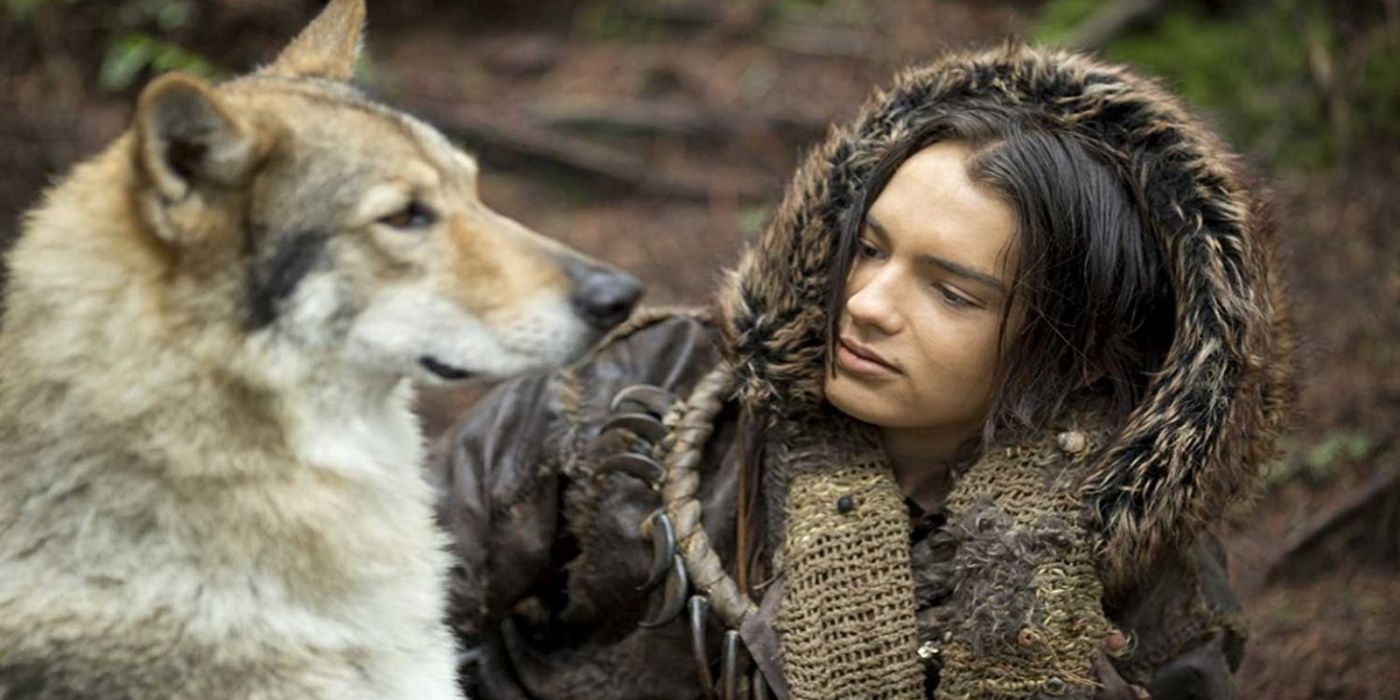
Initially overlooked upon its 2018 release, the prehistoric adventure film “Alpha” has since gained renewed interest among Netflix viewers. The movie offers a gripping portrayal of life during the last Ice Age, focusing on Keda (played by Kodi Smit-McPhee), a young hunter who becomes lost in the wilderness after being separated from his tribe. During his arduous journey home, Keda develops an unexpected bond with a solitary wolf, both of them depending on each other for their survival.
The story features captivating visuals and beautifully portrays the deep connection between humans and their loyal canine companions. However, one aspect that might go unnoticed (except for those reading subtitles) is its unique feature – the entire dialogue is in a language unknown to us modern viewers. As Alpha takes place about 20,000 years ago, it’s no wonder we find ourselves puzzled: what language do the characters speak?
The Language In ‘Alpha’ Is Completely Made Up

Though the actors deliver their lines convincingly, it’s important to note that every word spoken in Alpha is purely fictional. Given our current understanding of linguistics, it’s challenging to accurately depict human speech during the last Ice Age as there’s limited evidence available. This gap in history required the filmmakers to invent a new language in order to authentically immerse viewers into that era, and they enlisted an expert to accomplish this task.
Christine Schreyer, a linguistic anthropologist who teaches at the University of British Columbia, is the creator of a language called Beama. With a background in both Hollywood and preserving real languages for indigenous groups in Papua New Guinea and Canada, Schreyer has become an expert in established languages and constructed ones like conlangs. This diverse experience makes her uniquely qualified to address the puzzling word gap in Alpha’s language.
The Inspiration Behind Beama

Even though they had a language specialist on their team at Alpha, creating Beama was still a massive endeavor. Coming up with new words may seem as simple as making random noises, but crafting a language that’s organized and could resemble something early humans might have spoken is an imperfect art. In an interview with UBC, Schreyer stated, “We don’t actually know what was spoken 20,000 years ago since we don’t possess fossilized examples of language.” Consequently, when searching for inspiration for Alpha, she had to delve into hypothesized languages within the specified timeframe, such as Proto-Nostratic, Proto-Eurasiatic, and Proto-Dené-Caucasian.
Well, as a cinephile delving into the realm of linguistics, let me share an intriguing bit I recently discovered. You see, Beama wasn’t just a figment of someone’s imagination, but it was actually built upon other speculative languages from our historical past, which are rooted in familiar tongues we use today. To put it simply, imagine connecting the dots between French, Spanish, and Italian, then estimating those related languages back in time, with a dash of creative freedom thrown in for good measure. That’s essentially what Schreyer was getting at!
In simpler terms, the entire process involved taking proto-languages as a starting point and then creating modern language patterns to fill in gaps in Beama’s dialogue. This means that Alpha’s final script was a mix of dialogues that were estimated based on a natural speaking rhythm, which the actors and audiences could easily recognize and understand throughout the movie. In essence, developing Beama was a lengthy process, but it appears that all the effort was worthwhile considering the film’s growing fanbase.
’Alpha’ Filmmakers Were Dedicated to Authenticity

In crafting world-building films, focusing on making characters and settings feel genuine is crucial for audiences to fully immerse themselves in the narrative. While fantastical genres can invent new worlds, Alpha tells a story set in actual Paleolithic Europe, and its creators aimed for an unparalleled level of realism given their limited historical data. They strived to construct a prehistoric world that appeared authentic, designing dwellings, garments, tools, and even animals appropriate for the era. But it’s Beama, the wolf cub, that truly draws viewers in.
In Schreyer’s Alpha project, it was essential that she accurately depict the language. She communicated to UBC that her goal was to make it sound genuine and avoid creating something that seemed nonsensical. As an anthropologist, she was responsible for writing a full-length script using a fictional language. This required not only careful attention to the structure of Beama but also ensuring the actors could convincingly deliver the lines without tripping over the unfamiliar sounds, as such a performance might have resulted in a forgettable movie at best.
It’s fortunate that the cast of “Alpha” performed admirably during the production. As revealed by Game of Thrones actor Jóhannes Haukur Jóhannesson, who plays Keda’s father Tau, he found the work to be an engaging challenge. He shared with UBC that as he was learning the script, he started to notice a pattern and it began to make sense. Then, it seemed to unfold naturally – scene by scene, line by line. It was evident that this wasn’t hastily put together; instead, it was meticulously crafted with skill and expertise. We can attribute Jóhannesson’s quick understanding to his ability to speak four other languages. However, the dedication of him and his fellow actors to the characters and the project as a whole made “Alpha” the remarkable film that is now captivating audiences.
Alpha is now available to stream on Netflix.
Alpha | Official Trailer

Read More
- Grimguard Tactics tier list – Ranking the main classes
- 10 Most Anticipated Anime of 2025
- USD CNY PREDICTION
- Silver Rate Forecast
- Box Office: ‘Jurassic World Rebirth’ Stomping to $127M U.S. Bow, North of $250M Million Globally
- Gold Rate Forecast
- Black Myth: Wukong minimum & recommended system requirements for PC
- Mech Vs Aliens codes – Currently active promos (June 2025)
- Maiden Academy tier list
- Hero Tale best builds – One for melee, one for ranged characters
2025-04-15 00:32